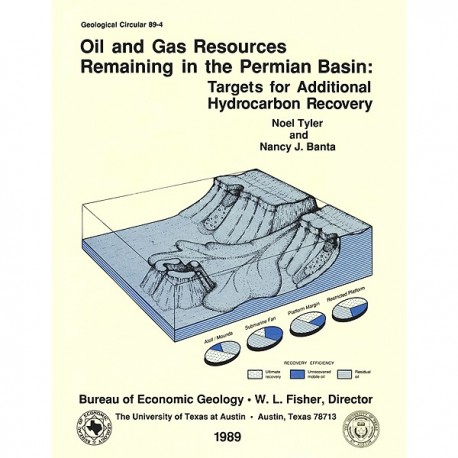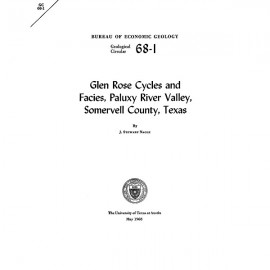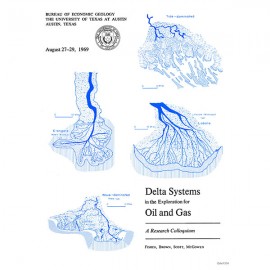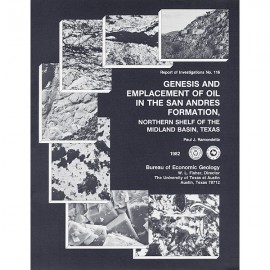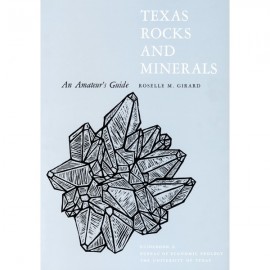Geological Circulars
-
Books & Reports
- Reports of Investigations
- Guidebooks
- Udden Series
- Geological Circulars
- Down To Earth
- Atlases of Major Oil and Gas Reservoirs
- Texas Memorial Museum Publications
- Environmental Geologic Atlas of the Texas Coastal Zone
- Mineral Resource Circulars
- Other Reports
- Seminars and Workshops
- Handbooks
- Submerged Lands of Texas
- Symposia
- Annual Reports
- Open File Reports
-
Maps & Cross Sections
- Thematic Maps
- Miscellaneous Maps, Charts & Sections
- Geologic Atlas of Texas
- STATEMAP Project Maps
- Geologic Quadrangle Maps
- Cross Sections
- Highway Geology Map
- Energy and Mineral Resource Maps
- Shoreline Change and Other Posters
- Wilcox Group, East Texas, Geological / Hydrological Folios
- Bouguer Gravity Atlas of Texas
- River Basin Regional Studies
- Featured Maps
- Posters
- Teachers & the Public
-
Geological Society Publications
- Gulf Coast Association of Geological Societies
- Alabama Geological Society
- Austin Geological Society
- Corpus Christi Geological Society
- Houston Geological Society
- Lafayette Geological Society
- Mississippi Geological Society
- New Orleans Geological Society
- South Texas Geological Society
- GCS SEPM Publications
- Historic BEG & UT Series
Oil and Gas Resources Remaining in the Permian Basin: Targets for Additional Hydrocarbon Recovery
GC8904
For a downloadable, digital version: GC8904D.
This product is no longer in stock
GC8904. Oil and Gas Resources Remaining in the Permian Basin: Targets for Additional Hydrocarbon Recovery, by Noel Tyler and N. J. Banta. 20 p., 14 figs., 2 tables, 1989. ISSN: 0082-3309. Print.
To purchase this publication as a PDF download, please order GC8904D.
ABSTRACT
Reservoirs in the Permian Basin of Texas are estimated to have contained a total of 105.7 billion barrels (Bbbl) of oil at discovery. As of January 1985, these reservoirs had produced a cumulative volume of 25.3 Bbbl of oil, and proved reserves were calculated at 5.9 Bbbl. Thus, of original oil in place, and given a projected recovery efficiency of less than 30 percent at current development and technology, 74.5 Bbbl of oil will remain in Permian Basin reservoirs at depletion. Eighty-eight percent of this unrecovered oil lies at depths of less than 8,000 ft.
Reservoirs of Guadalupian age, primarily the San Andres and Grayburg Formations (and to a much lesser extent the Yates and Seven Rivers Formations), dominate the oil-resource base, containing more than 50 percent of the original oil in place and 56 percent of the estimated ultimate recovery. In contrast, Leonardian Clear Fork platform carbonates and heterogeneous, low-recovery, Spraberry-Dean submarine-fan sandstones account for nearly 25 percent of the in-place oil but only 13 percent of the ultimate recovery. Of the original oil in place resource, 80.4 Bbbl remains. Together, mobile and residual oil account for 93 percent of the remaining oil; proved reserves total 7 percent. The cumulative volume of unrecovered mobile oil in excess of proved reserves in the Permian Basin is estimated to be 30 Bbbl, concentrated on the Central Basin Platform. Plays on the fringing shelves and within the interior subbasins are also good prospects for the extension of conventional recovery strategies. Restricted-platform carbonates, containing 44 percent of the remaining mobile oil, are the dominant reservoir rocks. They also contain 40 percent of the residual oil; thus, platform carbonates are a primary target for extended conventional and tertiary oil recovery strategies in the Permian Basin of Texas.
Keywords: Permian Basin, oil and gas reservoirs, unrecovered mobile oil, residual oil
Citation
Tyler, Noel, and Banta, N. J., 1989, Oil and Gas Resources Remaining in the Permian Basin: Targets for Additional Hydrocarbon Recovery: THe University of Texas at Austin, Bureau of Economic Geology, Geological Circular 89-4, 20 p.
